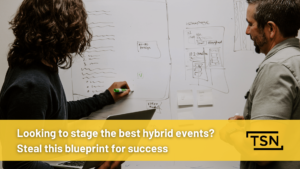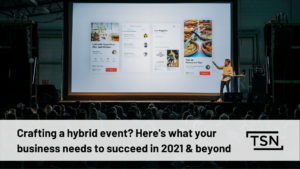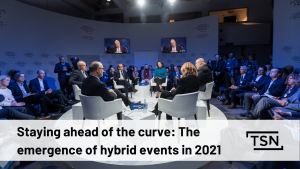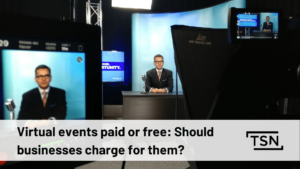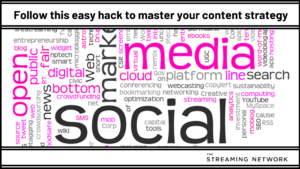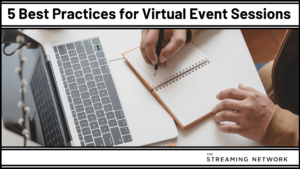Podcast: Play in new window | Download | Embed
Subscribe: Apple Podcasts | Google Podcasts | RSS
Last time, on “The Webinar: Lessons From The Front Line”, we discussed the craft of producing a webinar and how to make your webinars more fun.
In the latest episode, we will be diving into how you can identify your power leads. These are your prospects who have consumed quite of bit of your content. They are ready to talk to someone on your sales team.
Tune in as we discuss the following topics:
- Why is there an ongoing struggle between sales and marketing?
- How exactly should webinar marketers look at the viewer data?
- How to use the right engagement scores to measure commercial intent?
- How you provide your sales team with adequate information about leads?
The Complete Video Transcript:
Peter Vamos: Welcome to LFTF, the podcast by webinars and how to supercharge your B2B strategy. With me, as usual, is Matthew Ley, president of the streaming network. Matthew, welcome.
Matthew Ley: Thank you, Pete. How are things?
Peter Vamos: Things are good, things are going well.
Matthew Ley: –Good, good.
Peter Vamos: Happy to be here once again talking about this–this a, never ending subject, the subject that–that–seems to have–have no limits–
Matthew Ley: Yep.
Peter Vamos: And–and yet is–is–is always so very, very interesting. Today we’re going to talk about identifying leads from webinars.
Matthew Ley: Right.
Peter Vamos: So. You know, we get a lot of people asking us about lead scoring and–and tactical information like that and–and you know, this is the sort of stuff we talk about quite a bit –
Matthew Ley: Right.
Peter Vamos: And yet we still get people asking us questions so–
Matthew Ley: –yeah, we do.
Peter Vamos: –so–so, like why–why are we talking about this today, why are we still talking about this today. Why are we still talking about this today? Why are we still getting these–these kinds of questions–what do you think?
Matthew Ley: I think it’s because of the ongoing struggle between sales and marketing, you know, we need more leads, the VP of sales will say, and I say this from a place of an altruistic place as I come from a sales background not a marketing background. We need more leads and then when we get them, we say they’re crap. And we also know, and we’ve said it before, that the webinar’s a great place for qualified leads, people who’ve spent that much time with you are generally good leads. So this is–but was–if this is still happening in a lot of organizations they’re asking, well, what next. Like, what else do I need to do to make sure that we’re passing those good leads?
And the–and the case is–is that, you need to be looking at the viewer data in the right way.
Peter Vamos: Right. So–so–so how should we be looking at the viewer data? Like how —how does that–how does that play out?
Matthew Ley: Understanding the intent of what’s going on, and I think we all kind of get it, but when we’re wrapped up in a numbers game of getting–of hitting our KPI’s of number of people through or number of leads across, we can forget it. So when someone registers this means they have interest in the topic. It is not until they view the webinar in its live or on-demand state that we recognize they have a higher interest or their interest is–is timely and, from there, we look at how long they’ve viewed the webinar and that, again, if you’ve kept their attention for 45 to an hour, they’re showing a fairly high level of interest. And, most importantly, if they were there plus they engaged with your resources, polls, asked questions, now that person is of the highest level of interest. There is a big difference between saying yes, I want to come, and engaging for an hour with you, from an interest perspective.
Peter Vamos: Right. So, and this is something that we’ve–we’ve talking about many, many times.
Matthew Ley: Yeah.
Peter Vamos: –It’s–it’s you know, most engaged viewers are our best leads–
Matthew Ley: Right –
Peter Vamos: So–let’s–let’s–dig into that a little bit.
Matthew Ley: Yeah, I mean, we have talked about it, and the engagement score, which is, you know, part of our platform, it’s something we have talked about, like, a hundred times here, is —is a good start. But if you’ve followed everything and you’re not–followed everything we say and you’re getting, you know, good engagement scores, but you’re still not having the right effect in sales from pipeline growth or anything like that, it’s going to come down to this (sp).
So let’s talk about which stats represent commercial intent, and just because someone listens to this podcast in its entirety (unintelligible) a bunch of people who listen for about 20 minutes–we’re just trying to keep them shorter for you right now, does not mean you’re ready for a call from a sales rep or even a BDR (sp), and it doesn’t mean you’re looking at a webinar program at all.
And that’s because of the type of content asset that this is, right. So what would we consider our podcast series. What type of content–
Peter Vamos: Right.
Matthew Ley: –what type of content is this?
Peter Vamos: Right, right. Well that does make it hard.
Matthew Ley: Right.
Peter Vamos: Because –
Matthew Ley: It’s thought leadership, right?
Peter Vamos: Right. Yeah.
Matthew Ley: (Sorry) I’m not supposed to be asking you questions, you’re supposed to be asking me questions. I apologize. But this is thought leadership, right.
Peter Vamos: Right.
Matthew Ley: So, whether people are consuming this through their podcast download, on the blog or in the webinar format which it will be delivered, they’re looking to learn how to lead score, but they’re not looking to learn anything about our products or services. And so, that means that time viewed on this webinar is not the number one–or time viewed on this podcast does not show any commercial intent whatsoever. So, you’ve got to do different things to understand where that person is.
Peter Vamos: Mm-hmm.
Matthew Ley: And the easiest thing to do to understand if they’re in the buying process or they’re looking to evaluate your product or services is simply ask them. Right. So we focus a lot on getting people to engage with us, but we know that those who engage are the most motivated, so a simple step would be to–within a thought leadership webinar–is to give people the option to take the next step.
And that option might be meet with sales. That option might be to get a demo. In the case of this, in this webinar format, well, we’ll put two options in–in –in it. One would be if you want us to take you through how we could help you with our platform, click here and set up a meeting. Or, watch how–watch this additional webinar video whatever it is, on how the elite webinar platform allows you to better qualify leads in your webinar program.
So all the people who came here just to learn, who aren’t interested, they get to learn and walk away. That was the promise of this. Learn how lead score. But the people who are looking to do it better and possibly evaluate a platform to do that, we give them two options to take that next step, both of those options show commercial intent.
Peter Vamos: Right, good. And–and basically, you’re not–you’re not–you know–you know, passing–you know, bad leads over your sales (team) that’s sort of–sort of–
Matthew Ley: Exactly. Exactly.
Peter Vamos: Yeah. That’s sort of the idea. So, like, how do you–how do you provide more intelligent information? I mean (sp) this is really gets to the gist of what people are asking us about (unintelligible)?
Matthew Ley: Right.
Peter Vamos: How do you–how do you turn this and turn it into better intelligent information?
Matthew Ley: Okay. And so, the first thing is, is like, that–asking that question, and you can ask it through having a link on the–you know, a resource take the next step, you know, fill out this high value form. You can put a poll, how many people want to take the next step afterwards. That’s what I would call the (sql), right. But from the (mql) the great mystery that is, understanding that this person should be reached out to, that one’s harder and very hard on thought leadership. I would argue, probably not even a beyond the two things that I threw out there, there’s no way you’re really going to get inside the numbers on that unless you read the questions maybe and understand.
Peter Vamos: Hmm.
Matthew Ley: But in the aggregate, they need to click on one of those two things, right. And they click on that then they show a level of intent, enough intent for you to sort of take that next step. We’re going to get —in the next podcast, we’re going to get into, like, really deep on how we position resources in a webinar and what they each mean and what we know them to mean through our experience, but I think that, you know, different types of webinars, the stats matter differently. So in a thought leadership webinar, time in webinar shows interest in a topic, not interest in a product, but when you’re doing a product webinar or a demo webinar, time in is almost everything.
Peter Vamos: Right.
Matthew Ley: Right? If I–if this webinar was “How to get more of the Elite from Lead Scoring,” and it was a technical webinar that was all about the elite platform, and you stayed for 45 minutes and asked me questions and were highly engaged, all the stuff we talk about, you’re sales ready, you need manual intervention, you’re ready to start really evaluating this thing.
So the time (in) stat is very important. When it comes to marketers, though, what they should be doing, from a more intelligence standpoint, is doing the same thing they do on their website. And that is, looking at, in aggregate, the–the various things some have done. So on the website, you look at the time they were there and then how many actions they took.
For us, if they take, I think, it’s three actions, we call on them (unintelligible) we push it to the BDR team to follow up and book a meeting. So with most webinar (pro) firms, with ours specifically, you know how many actions they took within that webinar, and you know the value of those, and if you add those to what else the person has done, you may be able to look at someone on a thought leadership webinar who was on your website and watched this video and clicked on this one thing and then they came to a webinar and they clicked on this other thing, well, they’re a higher aggregate score.
Peter Vamos: Right.
Matthew Ley: Right. Or if they’ve viewed three webinars in one night on demand –
Peter Vamos: Right.
Matthew Ley: –they may have taken–they may have all been thought leadership, but if someone’s watching three webinars who is a non-existing customer of mine, or watching three of our podcasts, all on the are the of webinar, they’re a non-existing customer, something’s going on there.
Peter Vamos: Right.
Matthew Ley: Right. They need some help or some intervention, then, we should sort of give them a call.
Peter Vamos: And it really does speak to, I mean, one, knowing your strategy going in, what kind of–is it a thought leadership webinar, like, where your –who you’re targeting.
Matthew Ley: Right.
Peter Vamos: But also, do you need–you know, you need to thinking on your feet as well in terms of how you’re going to engage with them and what sorts of things you’re going to be doing to make those–those sorts of assessments.
Matthew Ley: Yeah. And I think it becomes. This is where, you know, certain things work for everybody. And a lot of our tips and tricks, and we go detailed on this, you’re going to see that it can work at any stage of the funnel for any marketer who’s trying to drive pipeline for their organization in any way. But some of the nuances of the (unintelligible) manual interventionist required or what, you know, or what are the high value items, they change from organization to organization.
And you only learn that and know that based around your own experience, right. So we can sit around and we can start at numbers, and we can stare at pipeline all the livelong day, but if things aren’t adding up, there’s something wrong and, again, the only answer is ask.
Peter Vamos: Right.
Matthew Ley: Right. So when we’re fairly confident and when we do a webinar and what actions make somebody an (unintelligible) for us are sales ready, we have an added advantage of that we sell webinars and part of the experience is a demo in itself. So we’re–we’re–we’re always killing two birds with one stone, but to get there, you know, what we had to do early on is, when we held a webinar, every person got contacted. Not under the guise of book a meeting, book a meeting, book a meeting, book a meeting with sales, or buy now or with an offer, but we categorized our leads from the A leads to B leads the C leads. We called everyone and we vetted our ABC. We asked them.
Peter Vamos: Right.
Matthew Ley: Right. So all the A’s were asked. You know, would you like to get on a call with the sales rep to review the platform and understand if it’s right for you. Everybody in B, we asked a softer question, did you learn everything you needed to from the webinar? Is there any other content that you are looking for? And C, we just said thank you, for attending, asked if they needed any other information from us and let them tell us to make sure that there was no-one in C that was looking for a demo or a quote right away.
Peter Vamos: Correct.
Matthew Ley: And that allowed us to adjust our algorithms and we knew who went to sales and who didn’t and who for, really, just stayed in the marketing drip for us.
Peter Vamos: Right. And that’s basically–I mean, that’s the approach to–to, you know, thought leadership, right.
Matthew Ley: Yeah.
Peter Vamos: –I mean, that’s–that’s–that’s (unintelligible). So and this data is incredibly valuable.
Matthew Ley: It is, and you know, look. We say this often. Even if you do a thought leadership webinar that is, you know, you bring in a third-party guest, right, and you’re talking about something that leads to very little commercial intent. People are there because that person is talking, and you put up the–you put up the calls to action and you know, you’ve got a high percentage of people who do not take action. Right. Because they’re there for the promise of the webinar.
Peter Vamos: Right.
Matthew Ley: They’re there for the content. But you’ve got them there. Might as well use that time to do what anyone would do when they’re first talking to somebody, right. So the thought leadership webinar, new blood in the funnel, top of funnel content, you may have a whole bunch of people that show up, hopefully, who were not already within in your pipeline and were not active within sales. And so, you can use different interactive tools to bb qualify them.
So questions we like to ask within our webinar, whether or not we’re talking about anything to do with viewership or number of events or anything is we ask this question about how many events do you run in a year. And that’s because the more events you run, the better fit you are for us as an organization. So these fit questions can be delivered in polls or utilizing the survey.
Other questions like, how likely are you to evaluate platforms in this fiscal year? This is a question that buyers or viewers want to answer, so you’re not bugging them if they’re–if they’re not interested in it, or if they are, you know when it is you want to follow up, so utilizing asymmetrical polling, what’s this polling that goes out through the webinar but is not necessarily related to the–the content and a survey to better qualify your opportunities and get data that you can’t get from Scotts or ZoomInfo or the like is another great value of the thought leadership webinar, another way for you to help qualify the quality of the lead.
Peter Vamos: Right. And this is, obviously, a completely different approach than if you’re further down the funnel.
Matthew Ley: Yeah. Yeah. I mean, it is completely different. I mean, further down the funnel, if you know you’re further down the funnel, and I mean, this is a–we can go down a rabbit hole here, right.
Peter Vamos: –That’s the —
Matthew Ley: –and we–and I–
Peter Vamos: –That’s the million-dollar question.
Matthew Ley: Exactly.
Peter Vamos: –where–where, exactly, are you in the–
Matthew Ley: –yeah, who are you targeting with your webinars, right? Are you targeting everyone and getting people attending a real down funnel webinar that they’re not ready for? Are you having a conversation about how webinar–I mean, how your product is used at the enterprise, to a whole bunch of people on the SMB market, like, all these things matter? The more targeted you can become, with your–with your–who you’re inviting to the webinar, means that every viewer, every stat and everything that happens, every engagement number within it, more valuable than it was before.
Peter Vamos: Right.
Matthew Ley: Right. Most people when they’re doing a webinar, especially in the early days, and we’re focused on how do we get the most people to it, we’ve got to rule out tire kickers. We’ve got to rule out the wrong type of buyer. We’ve got to rule out all kinds of different things, right? Before we even get to those people and then we start looking at which of those people were in longest and did–and did the most. So targeting can really help in all cases. And we’re going–we’re going to talk about it later because I think it’s a real change that we’re seeing within our customers, is having the webinar used as more of a scalpel than a sledgehammer approach.
Peter Vamos: Right. So you’ve got people who’ve been using listening to–to–you know, our podcasts, they’ve–they’ve attended the better webinar events, but they’re still struggling with–with–with the–the question of what–what–to do with–with leads.
Matthew Ley: Right.
Peter Vamos: How–how–how do we–what can they do?
Matthew Ley: I mean, we’re always going to struggle with that because we always want–what we really want–and that’s the thing to remember, right, is what do we really want right. So when we go into a webinar we have to have realistic expectations, what are we looking to do. So in the case of thought leadership, nine times out of 10, you’re looking for new blood in the funnel, the right prospects knowing who you are, getting in and getting to know you a little a little bit, which is why you do these, sort of, these–these types of pieces, and so, you should have realistic expectations that that is not going to necessarily drive pipeline for you immediately. That you are going to do a job of getting people into the next step, right. Getting them to some sort of piece of evaluation-based content. And in many cases, it’s not the process that your sales director wants to be or maybe even you want it to be, right.
And so, you’ve got to give people options to get to that stage. And in my earlier example, if no-one wants to talk to us after this–after something like this, but they want to watch a, you know, a 10-minute demo on our product and how it leads scores, I have successfully taken somebody who is not a customer, who possibly I didn’t know, into a stage where even if they weren’t ready for it organizationally, they’ve started to evaluate our product.
And that’s the goal, getting them into that stage is really the goal. And when you’re further down the pipeline, it’s every stage and everything is different right. You know, maybe it’s–you’re an–you’re in a place where people are self-evaluating, and you really want them to engage to get to that quote status. You need to get something in paper with them, and so to do that, they get through this webinar and that’s what you’re driving, is quotes issued or contracts issued, proposals issued, and maybe it’s simply to drive people to sales, which is what a lot of people in B2B want, as a next step when going through this is getting them in front of sales reps.
Peter Vamos: Mm-hmm.
Matthew Ley: And, if that’s the case, then you’ve got to keep your eye on–you know, understanding, how it is–how it is that you a, use the tools in front of you to drive people there and then b, what’s a reasonable number to expect, which is going to change based around who you are and how involved your program is. So the idea around being reasonable with it and then working everything around that target and knowing what that KPI is, I think, will help marketers deliver better quality leads to their sales organization.
Peter Vamos: And one of the things that, you know, we–we–we believe, firmly, and–and stuff that we–we talk to our clients about is–is that having more viewers isn’t necessarily everything, right.
Matthew Ley: No.
Peter Vamos: It’s the–it’s the (unintelligible). There’s all kinds of factors that go into the number of people that are actually engaging with your–whatever the content is, in this case, webinars, but whatever it is.
Matthew Ley: Yeah, I mean–I mean, we’ve got two–we’ve got a number of buyer personas, but if I look at two market buyer personas that–just popping into my mind, one of them we have a 65% close percentage when we get through, the first being in a demo. The other one, we have less than 20%. That has very little to do with our process and everything to do with fit. Right. They don’t run enough webinars or the organization is not in the right industry or size to work with us.
So, when, if you look at it from a very high level and your goal is leads, it’s not just–we’re not in a world anymore where it’s just giving as many names and phone numbers to sales as possible, it’s about giving the right names–the Glen Gary (sp) leads.
Peter Vamos: Mm-hmm.
Matthew Ley: –than the ones that are sales ready. That’s your job as a marketer. So a–for us, someone coming through our program, what we do here in the next stages of it, if they’re–that buyer persona who’s in that 65% close rate and we’re able to move them through our podcast and our other content into getting into one of our sales reps, the value of that’s way above 100 of the other ones, even, because I didn’t even mention those deal sizes are way bigger, too, on the 65%.
So the–the key here, is that, yeah, your KPI’s shouldn’t just be number of registrants, number of viewers, although, that’s important to watch, your KPI’s should be how you’re impacting the organization. And they will likely change from webinar to webinar or, at minimum, from type of webinar to type of webinar.
Peter Vamos: Right. Now how do you test something like that? Like, how do you–it’s–it’s–it’s, I mean, it’s more than a theory–you’ve–you’ve seen it work?
Matthew Ley: Yeah.
Peter Vamos: But how can you–knowing that each company is different, and has different criteria, how can you–is there a way to test that?
Matthew Ley: Yeah. Yeah, there is. When you’ve got proper sales and marketing alignment, definitely there is right. So the hard part about today’s day and age versus before is, just in the past, people would a lead got to a sales rep, and a sales rep closed. Now when a deal closes, there’s seven people who were involved, 17 pieces of content that the person viewed before they got there. And it’s not quite as linear of a process.
So it makes it really hard, but with proper sales alignment–sales and marketing alignment, where you’re tracking the right things, you can understand, you know, the–the deal closes–when the deal closes close to a webinar you get to understand the proximity, you get to understand where that lead received its acceleration if you’re measuring things properly in the pipeline, and if–you don’t got that level of sophistication in your tracking which, I assure you, you know, we do not on our side, I just seen it on our customer side, then you ask. You ask.
Peter Vamos: Straight up.
Matthew Ley: Straight up. Who cares? Sales gets a commission anyways. Have them ask the question. When did you–you know, why did you decide to purchase from us? You know, what was the value of this. And on the flip side, if you’re giving what you think are really high qualified leads to sales and they’re not closing, ask the question as well, when you don’t get the deal. So you can tweak all of your metrics. And next time, that’s what we’re going to do. We’re going to dive in on some tricks that always work, but allow you to cut through the crap and really dive into–dive into how to position your webinar to get you those metrics.
Peter Vamos: Great, great. Well, that’s a good ending then.
Matthew Ley: Okay.
Peter Vamos: That’s a good way to close this off. Our next podcast is–is as Matt alluded to is a step-by-step approach how to accomplish everything we just talked about at–at–at any point in your funnel. This is LFTF, the–the podcast about webinars. Matthew Ley.
Matthew Ley: Peter.
Peter Vamos: Thank you, as always.
Matthew Ley: Thank you.
Peter Vamos: And we’ll see you again.

